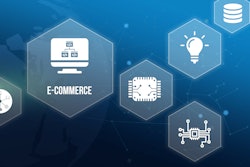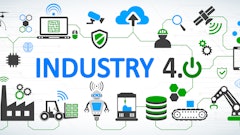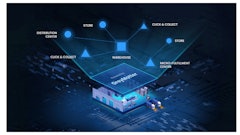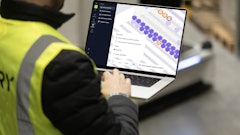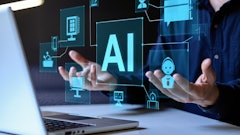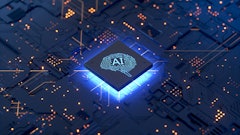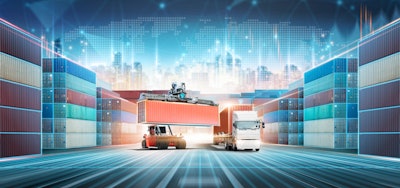
As we step into 2025, supply chain technology continues to be a dynamic and critical resource for shaping global commerce. Advancements in AI, Internet of Things (IoT), blockchain and automation have redefined how goods are sourced, transported and delivered. On the precipice of a new year, the state of supply chain technology brings along anticipated advancements, the power of visibility and the persistence of cybersecurity challenges that need urgent attention.
Advancements on the Horizon
Next year promises transformative advancements in supply chain technology from AI to track and trace. AI and ML are expected to take predictive analytics to new heights. Mike Kreider, chief information officer at DHL Supply Chain, says considering the growth of AI in the supply chain, expect major developments within the next five years. This will have a powerful impact on customer-centric business approaches for logistics companies, as use cases are identified across a multitude of workflow processes at all transactional levels.
In the future, Michael Hung, CEO at TradeBeyond, says it’s clear that AI will play an even greater role, and as these systems become more sophisticated, they will not only help identify and mitigate risks but also adjust operations dynamically to align with sustainability standards and market demands.
According to Jared Green, director of global sales, automation & emerging technologies, at Crown, some of the most significant technological advancements currently shaping the supply chain industry include operator assist technology, real time location systems and enhanced telematics solutions. These technologies can be powerful tools on their own, explains Green, but as more providers collaborate with customers to integrate these data streams into their existing business systems, the value generated could grow exponentially.
 thodonal/stock.adobe.com
thodonal/stock.adobe.com
"This is pointing out 3 significant technologies but when it comes to highlight the most significant one, I would rather say it's the capabilities of cloud computing, making now all this possible and not only for big players but to each and every company and this is a game changer as it will emphasis emerging new players and more innovation in the supply chain industry," says Rominger. "Enhanced algorithms will provide more accurate demand forecasting, inventory management and route optimization. These tools will help companies reduce waste, manage costs and improve customer satisfaction by preempting market fluctuations."
Today's robotics aren't the Jetsons of yesteryear. Ben Lee, VP of integrated systems sales at Swisslog, says in the supply chain, automated robotic solutions and software technology support market growth and provide greater control and visibility of the whole supply chain, while also offering a more robust, dependable solution— in which the end users can more confidently base their business objectives, quality control and capacity plans. In addition, automated solutions lower operational costs and increase the speed and efficiency of distribution supply chains.
"One of the things we will continue to see is software playing an increasing role in maximizing productivity of robotics. Robotic systems will no longer be optimized mechanically, but rather with software. For instance, the physical speed of robots is nearly at its maximum. For further gains to be made, it now becomes about optimization through the use of software that incorporates AI learning and helps facilitate a more effective use of data," explains Lee.
Blockchain adoption is likely to grow as companies recognize its potential for secure, transparent record-keeping. Enhanced blockchain networks will allow end-to-end traceability, offering stakeholders confidence in the authenticity of products, from raw materials to final delivery.
"Blockchain technology exists today and is applicable to many segments along a supply chain, although not necessarily to the same degree. To maximize the benefit and utility of blockchain, however, companies need the right data and thus various methods of data collection. This requires coordination and collaboration among many players in the typically highly diverse supply chain ecosystem. Therefore, the small number of blockchain implementations of today are likely to need several more years before they mature to meaningful, comprehensive integration within the end-to-end supply chain," says Kreider.
Implementation Strategies and Benefits
Where technology ends and implementation begins, there are several strategies to getting innovation to work for you. Finding where the most logical application makes sense can sometimes be the determining faction in which solution works, and which doesn't. For example, Lee says, AI in the warehouse makes for more dynamic, more agile and more responsive spaces. It is enabling robotics to self-learn from experience, which means that robotic picking ability improves over time with enhanced picking strategies for new products.
As we delve into AI, a new emerging space for supply chain use comes in the form of Generative AI. With Generative AI, Kreider explains, there's been an expansion in applications that are automating certain back-office processes, as well as supporting operational processes.
"These can range from streamlining IT helpdesk requests, automating simple HR inquiries, or generating translations. In addition, we believe there will be a steep increase in adopting sandboxed environments in which companies can use generative AI tools to try new ideas and initiatives," says Kreider. For example, DHL has developed its own GenAI Hub to test out automating certain processes, developing content and generating information, all with a product funnel approach that includes a pilot period. Two of the use cases in this funnel include:
- A GenAI application for business development that provides insight by enabling faster analysis of a customer’s requirements. With GenAI handling the data, business development colleagues can focus on the customer’s challenges. This allows the business development team to quickly create more accurate and personalized proposals.
- A GenAI application for solutions design provides colleagues a data cleansing tool. With GenAI quickly cleansing and sorting the data, solutions design colleagues are able to respond faster and with more enhanced solutions.
Integration really becomes pertinent within these high-impact areas where AI can replace repetitive manual processes.
"Multi-enterprise platforms serve as central hubs that allow seamless data exchange between departments, suppliers and logistics partners. By consolidating data on these platforms, companies can access real-time information, allowing them to make quicker, more informed decisions and ensuring alignment across the supply chain," says Hung.
The two main ways for companies to integrate emerging technologies Rominger describes as these: 1. They either they rely on third parties such as SaaS Software providers having these capabilities already enabled in their solutions or 2. With the easier access to native cloud services, they are able to build the solution suiting the best to their specific requirements.
"In both cases the promise is to get more control on their supply chain and a better visibility driving costs down. In my role, with my experience and interaction with customers I can only give tangible benefits in a context of going through third parties SaaS Software," explains Rominger. "What we see mainly is improvement of the service level coupled with a reduction of the inventory and possible scraps. They benefit from a short-term return on investment with low risks around change management or possible failing projects."
Powerful Visibility and Transparency
Ultimately, companies that successfully integrate AI are seeing faster response times to market changes, improved compliance and enhanced ability to forecast and plan accurately, according to Hung. Traceability solutions offer an automated chain of custody that helps businesses verify product origins and compliance standards. This saves time on audits and gives companies a reliable, transparent way to track products from origin to destination, supporting both operational efficiency and sustainability goals.
In 2025, supply chain visibility will remain a top priority. Organizations are deploying many of these technologies for this specific use including IoT sensors, blockchain and AI to provide real-time insights into every link of the supply chain.
"Blockchains, paired with logged records from sensors, provide greater visibility of products as a trusted, immutable ledger. Supply chain professionals and customers can access a blockchain ledger with an interface from which they can see each product’s shipment status and accurately confirm product attributes, such as whether it was locally produced, organically grown, or received certifications," says Kreider. "Additionally, using blockchain technology, companies can quickly identify points of unauthorized removal or the insertion of products, helping to investigate theft, fraud and counterfeiting. Finally, with hundreds of international trade laws and regulations, a blockchain-supported level of transparency enables supply chain organizations to ensure supplier and distributor compliance."
Transparency strengthens relationships with partners and customers, allowing businesses to stand out in an increasingly ethical consumer market. It also ensures compliance with regulatory standards, such as environmental, social and governance (ESG) requirements.
ESG innovations are also reshaping how companies approach social and environmental responsibility. As Hung explains, tools that map and assess environmental and social impacts throughout the supply chain are helping organizations ensure they meet their ESG goals more effectively. In an example, TradeBeyond’s AI-powered chain-of-custody solution helps companies validate and track product origins through each stage in the supply chain. Solutions like these aid in regulatory compliance but also allows for more efficient documentation, which builds trust and transparency with consumers who demand sustainably produced goods.
"Implementation of new technology often creates a need for more visibility and transparency. Specifically, if customers are working on continuous improvement initiatives or deploying new technology, a deep understanding of the operations and supporting processes is required to ensure success. Wireless fleet and operator management systems, like those by Crown, have continued to evolve to capture and better manage this information. Technology providers are beginning to utilize simulation and advanced reporting tools to help guide customers through their technology journey," explains Green.
Threats of Cybersecurity
While technology is revolutionizing the supply chain, it also introduces vulnerabilities. Cyberattacks on supply chains have grown in frequency and sophistication in 2024, targeting weak links in the network to disrupt operations.
 KanawatTH/stock.adobe.com
KanawatTH/stock.adobe.com
"It’s also important to have external evaluations with different kinds of certifications confirming the good practices in place but also identifying possible improvements in a constantly changing world. Data privacy protocol, encryption in transit and at rest is another standard practice adding safety. When it comes to AI and very important additional factor is to ensure that anything sensitive either in the questions asked to Generative AI for instance will stay in a kind of private space and not be used to enlarge the public knowledge that can then be reused outside of the expected landscape of use," says Rominger.
Today, companies are using AI and ML to identify the unusual patterns and anomalies that indicate potential cyberattack. Kreider says in order to mitigate damage, these technologies can quickly adapt to new threats and automate response actions. Companies can also use behavioral analytics to monitor user and network behavior, detecting the deviations from normal activity that signal potential security breaches.
"Quantum computing can also provide an extra layer of digital privacy and security to counteract hacking. For example, quantum mechanics principles can be used to create almost unbreakable cryptographic keys and ensure secure communication channels are resistant to quantum attacks. Quantum computing can accelerate ML algorithms used for anomaly detection, pattern recognition, and real-time threat analysis. In addition, quantum computers can simulate complex cybersecurity scenarios and potential threats more accurately and rapidly, helping companies achieve proactive defense strategies," says Kreider.
Supply chain technology in 2025 will be even more intelligent, interconnected and efficient than we've seen. However, success will require not only the adoption of the right cutting-edge solutions for you but also a commitment to visibility and transparency to mitigate cybersecurity woes. Organizations that embrace these advancements while safeguarding their networks will lead the way towards supply chain excellence.




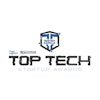


![Top Tech Logo Vertical [color]](https://img.sdcexec.com/files/base/acbm/scn/image/2024/11/top_tech_logo_Vertical__color_.672d2a7c2733d.png?auto=format%2Ccompress&bg=fff&fill-color=fff&fit=fill&h=167&q=70&w=250)
